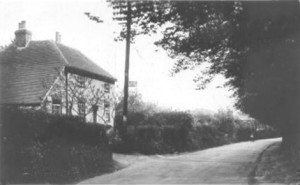The Tailors.
The Church Street Poor House accounts show many payments to tailors and dress makers for clothing for the poor, and the various 19th century censuses record several dress makers and tailors in various parts of Nonington parish. The coming of the railways in 1861 and the subsequent ready availability of cheap mass-produced clothing gradually forced them out of business by the later part of the 1800’s. Most appear to have been small concerns working from home with one exception, the Holtums.
Payments to John Holtum are recorded in the Poor House accounts of the 1820’s and 30’s, other Holtums were listed in the parish rates prior to this but no mention made of their profession.
The 1841 census records John Holtum, then aged 50 and a tailor, as having a tailor’s shop, now known as “The Limes”, in Easole Street situated next door to the bakery. Presumably this is the same John Holtum recorded in the Poor House accounts, and who would have lost the Poor House business when it closed in the mid-1830’s. John’s widow, Maria, was recorded as the proprietress of the business in 1851, which then employed her son, John, and three other men. In 1871 Maria, aged 86, was still listed as a tailor with John as the foreman. The 1881 census records John as a master tailor but by the end of the 1880’s he had disappeared from trade directories and census returns and no large village tailoring businesses are listed in subsequent censuses but individual women were listed as seamstresses, probably just doing alterations and repairs or specialised work. By the 1880’s the railways and mail order had given people in Nonington people easy access to cheap, mass-produced clothing through the post or by visiting towns such as Canterbury or Dover.

The Bakers
For many years the village bakery was situated to the rear of what are now the two cottage next to Home Farm. The earliest record of a baker in parish tax records is Jacob Chandler, who was also the corn miller until giving up the mill around 1819. John Chandler, Jacob’s son, is listed as the baker in the 1841 census but no bakery is listed in or after the 1881 census.
The various general stores.
Easole Street

Mrs. Hill’s shop in Easole St., opposite the Baptist Chapel. Later run by Mrs. Gillam, it closed in the early 1970’s.
George Kirby, a single master butcher aged 22 and his sister, Emma, single and aged 18, were listed in 1871 as living in Easole Street with George employing Frederick Allen, a journeyman butcher, who also lived on the premises. This apparently short lived butcher’s business may have preceded the small grocers and general stores opposite Nonington Baptist Chapel which was originally run from the early 1900’s by Mr. Hill and then by Mrs. Gilham and closed in the late 1960’s. The shop sold tinned and fresh food, tobacco and sweets, and small children, myself included, were fascinated by the bacon slicer which used to stand at the back of the shop.
For many years there was a general store in park gate keepers lodge at the Holt Street entrance to Fredville Park. Initially the Woodruffe family, who lived in the lodge, sold produce grown in the Fredville mansion walled garden from their home. The business was very successful and eventually shop premises were added to the front of the house during the 1930’s. The Lodge Stores shop had various proprietors over the years, the longest serving was Mrs. Pilcher, and the shop finally closed in the early 1990’s. The shop front was removed and the lodge returned to its original state which can be seen in pictures on the Fredville Gate Lodges page.
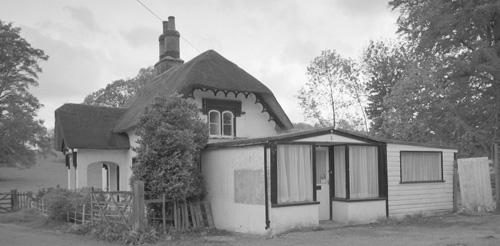
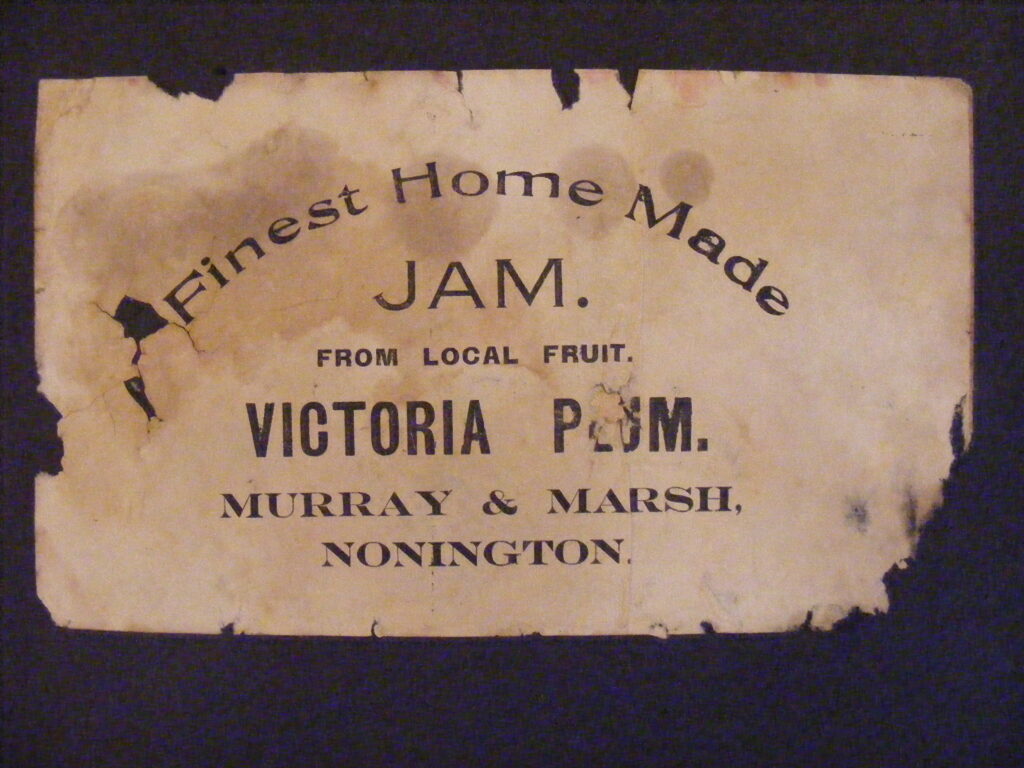
For a short time in the 1930’s the Murray family ran a grocery business from the Easole mill premises, taking orders and then delivering the items ordered to local people. One of the sons, Jimmy, along with Peter Broadbent from nearby Elvington, later went on to play football for Wolverhampton Wanderers in the 1950’s.
The Old Court Hill general stores and linen drapers
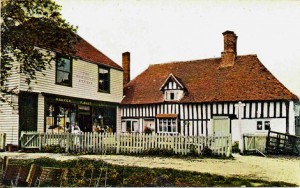
The Old Court Hill Stores, now Farthingales, circa 1910
Some of the older residents of the parish will remember when Mr. Hogwood’s ran his grocery business from the shop at the bottom of Old Court Hill, then generally known as Shop Hill, which closed in the late 1950’s and was disused for some years until the house and premises was sold in the late 1970’s by the late Lord Fitzwalter. The then new owner, David Peacock, renovated the house, now called “Farthingales”, and converted the shop into living accommodation and some of the outbuildings into a pottery workshop. After David Peacock sold Farthingales it became a successful bed and breakfast business and continues as such.
The medieval timbered farmhouse had for centuries been part of a small tenanted farm and eventually became part of the Goodnestone estate in the mid-1700’s. The 1851 census recorded Mrs. Sarah Holloway as the tenant farmer farming 24 acres and employing two labourers, and later in the decade she used part of the premises to open a linen drapers. The business must have been successful because by the time of the 1861 census Mrs. Holloway, then aged 61, was a draper and grocer employing two shop servants as well as being the farmer of 27 acres who employed one man and a boy with a house servant and a carter living on the premises. Sarah had retired by the time the 1871 census was taken, she had been succeeded by George and Eliza Holloway, her son and daughter-in-law, who then farmed 28 acres and employed one labourer and two general servants. By the time of the 1881 census George’s wife had died and he was described as “Grocer, Draper, Coal Merchant and Farmer of 28 Acres empl 2 men 1 boy” with Agnes H Stiff, a Dover born single woman aged 27, described as “Grocer & Drapers shopwoman” living in on the premises along with George Holloway, his 11 year old grandson, and Fanny Lawrence, a 15 hear old Whitfield born general servant.
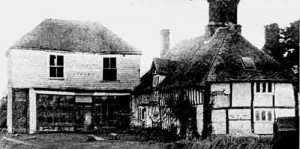
The Old Court Hill stores at the time of their sale in the 1970’s.
The farm and shop changed hands in the late 1880’s, and in 1891 Robert Sisley was the farmer, grocer and draper there. By the time the 1901 was taken the farm had been separated from the shop and Sidney Palmer Clay was listed only as a grocer and draper. From the early 1900’s until the shop’s closure shopkeepers included: Kane and Lloyd, grocers and drapers; Fred Best; Vye’s of Canterbury and finally Mr. Hogwood, initially Vye’s manager until their decision to close the shop when he took over it’s running on his own behalf. His daughter, Peggy, lived there until just before the premises were sold in the 1970’s by the late Lord Fitzwalter to David Peacock.
Post Offices
Great changes took place to the British postal service with the introduction of the Uniform Penny Post on 10th January, 1840, which charged a single pre-paid rate for delivery anywhere in Great Britain and Ireland and on 6th. May, 1840, the first adhesive postage stamp, the Penny Black , was introduced. Another postal innovation of the period was the introduction of William Mulready designed pre-paid postal stationery letter sheets and envelopes.
John Nash, the licensee of the Royal Oak, was the receiver of mail for the parish in 1845, and it is almost certain that the licensee of the Oak had taken over this duty when the White Horse in Church Street had closed in 1832, the White Horse’s licensee presumably having fulfilled the post of receiver of mail for many years previous. After his death John was succeeded as licensee and receiver of mail by his widow, Harriet.
1839: Uniform Fourpenny Post introduced.
1840: Uniform Penny Post introduced.
1840: First adhesive stamp (the Penny Black).
1852: First Post Office pillar box erected in Jersey.
1853: First post boxes erected in mainland Britain.
1857: First wall boxes installed Shrewsbury
and Market Drayton
1870: Post Office begins telegraph service.
1870: Post Office Act banned sending of `indecent or obscene` literature; introduced the ½d rate for postcards; banned the use of cut-outs from postal stationery; introduced the ½d rate for newspapers; provided for the issue of newspaper wrappers.
1880: First use of bicycles to deliver mail.
1881: Postal order introduced.
1883: Parcel post begins.
1894: First picture postcards.
1912: Post Office opens national telephone service.
1919: First international airmail service.
By the mid-1860’s William Cannaby, a market gardener, was the sub-postmaster at the Post Office premises in Easole Street near to the junction with Holt Street and Church Hill, later Vicarage Lane. Vicarage Lane is still generally known to locals as “Oak Hill”.

A view of the beginning of Easole Street when entering from Holt Street. The first post office building was in the first house on the right, the doctor’s surgery in the second.
The Post Office expanded to sell groceries and remained on these premises until some time in the 1890’s as by the 1901 census the Post Office had moved to the house in the Drove (lower Holt Street) which is still called the ‘Old Post Office’
The Post Office expanded to sell groceries and remained on these premises until some time in the 1890’s as by the 1901 census the Post Office had moved to the house in the Drove (lower Holt Street) which is still called the ‘Old Post Office’
The old Post Office in The Drove, lower Holt Street.The PO sign can be seen on the telegraph pole
In 1861 William Wanstall, a cordwainer and boot and shoe maker, was listed as the occupier and he lived and worked there until his retirement after which Clara and Louisa Holtum, his grand nieces, ran a grocer’s which was listed in the 1871 and 1881 censuses. By 1901 Thomas G. Batchelder, carpenter and post-master, previously the occupier of the Easole Street post office, had moved to the Drove premises where the Post Office occupied an extension built onto the side of the house which is still there.
The Post Office was here until just prior to the Second World War when the Post Office moved into premises purpose built by Mr. Tom Clayson, at the junction of Easole Street, Holt Street and Oak Hill, where in addition to post office services it also sold a very wide variety of items. The Post Office continued to serve the community under various proprietors until the early 2000’s when it was closed and the premises converted into a dwelling.

Mr. Tom Clayson outside of his new Post Office opened in 1938
The Easole Street Chemist’s
At the Holt Street end of Easole Street there was for many years a small, black wooden building which for many years was the village chemist’s. Originally the chemist was run by Mrs. Fermor and then later her daughter, Mrs. Nora Dyson. Villagers could leave prescriptions to be filled by Mrs. Fermor’s husband at his pharmacy at Eythorne, purchase remedies and toiletries as well as wool and also use the lending library for 3.d. or 6.d. per book. The chemists closed at the end of the 1960’s and was then for several years an antiques and bric-a-brac shop. The building was then left empty for many years and after suffering some fire damage the building sadly deteriorated beyond repair and was eventually demolished in 2023
The Holt Street businesses
The present Holt Street garage was once a cordwainer’s (leather worker) and boot makers premises and the cordwainer’s wife was a laundress who used the old brick building by the road as a laundry. The family lived in a thatched cottage at the bottom of the garage yard which fell down during renovation in the early 1960’s. The premises became a garage in the 1926 when William Sayers moved his business there from buildings at the rear of “The Royal Oak”.
In 1918 William Sayer, opened a cycle repair & taxi service in stable buildings behind “The Royal Oak”, later the car park. The pub at that time was run by his family.
The business expanded to include motor vehicle repairs & fuel sales. In 1926 William Sayer moved to the present garage premises in Holt Street which had previously been the public laundry. On his retirement in 1948 the business was taken over by his nephews, Charles & Arthur Betts, the business is now run by Terry, Arthur’s son.
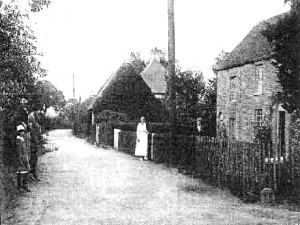



Opposite the garage was a boot and shoe repairers run by Mr. Prebble. A veteran of WW1 who lost a leg in the conflict, “Pop” Prebble ran a the business from his house in Holt Street from a small workshop built onto the side of his house, now called “Repart”.
Overlooking the road next door to “Repart” stands a small brick building, now sadly hidden behind tree and falling into disrepair. The building was used until the 1920’s as a saddler’s, harness maker’s and boot maker’s shop. It has a large south-east facing shuttered window which allowed the saddler to work by natural light whenever possible. As horses were gradually replaced by motor-vehicles business declined and the shop closed in the 1930’s.
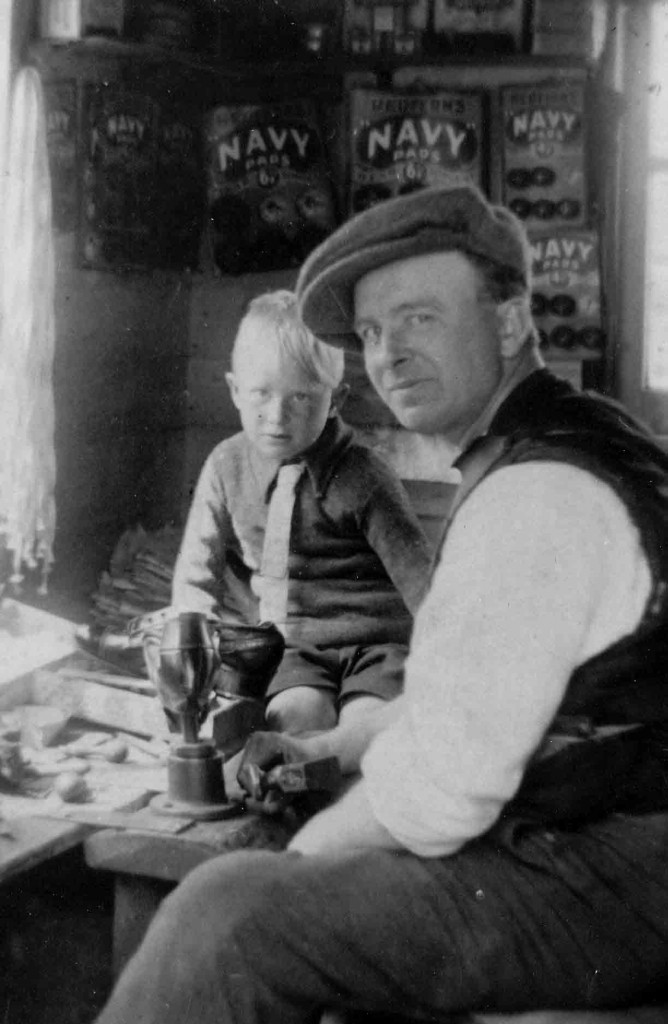
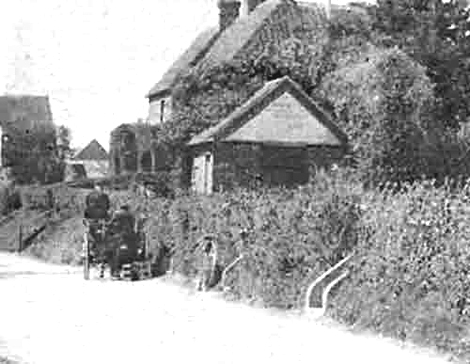
Above left: Mr Prebble & son Cyril in the shoe repair workshop. Above right: the saddler’s shop, the boot repair shop was on the end of the house visible in the top of the photo
Before the 1890’s the parish had several cordwainers and boot and shoe makers, who usually worked at home but by 1910 only two were left as cheaper mass-produced shoes became widely available.
Frogham & Ratling
In Frogham Street the Allen sisters ran a grocers shop which was recorded in the census returns from 1841 or earlier until at least 1881 in premises situated next door to Park Farm. The 1881 census record Edward Allen, a 65 years old widower and carpenter as head of the house-hold, and Charlotte and Mary Ann, his unmarried sisters aged 71 and 62 respectively, are listed as grocers. The business would have been run from the house or an outbuilding, probably with a small stock of everyday necessities and then taking orders from local people for special item which would then be bought in by local carrier from Canterbury or Dover. Items were almost certainly supplied “on tick” to the majority of their customers.
The 1851 Ratling census recorded Mrs. Mary Green as a shop-keeper and Thomas Groombridge as a beer-shop keeper. In 1861 Mrs. Mary Ann Green, shop-keeper, and Eliza, her daugher and a shop-worker, were living at Prospect Cottages, Ratling, but Thomas Groombridge’s beer-shop had gone. and by 1871 the Green’s were no longer listed as shop-keeper’s.

